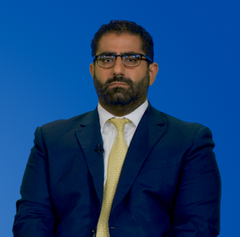
Accelerated Diagnostic Testing for the Detection of mNSCLC
Experts emphasize the crucial role of swift diagnostic testing, especially through liquid biopsies.
Episodes in this series

Mark Socinski, MD: So, Martin, as you well know, we’ve seen in the past 20 years or so with increasing numbers, as I count them, 5 mutations. We have 4 fusions, depending on how you count them, that have FDA-approved therapies in stage IV. At the time of diagnosis, what’s your strategy to make sure that you haven’t missed the opportunity to give someone a targeted therapy?
Martin Dietrich, MD, PhD:I think this is now extending beyond stage IV as well. One of the reasons why I think this is so important is because many times discussions we had about reflex panels and reflexive testing were, well, is that the right stage? Was it the right histology? I do think at this point we have messages that transcend across all stages and histologies of lung cancer. So with the hospitals that we work at and the tests we do, we would like to have reflex testing. I do think that with liquid biopsy—and none of the prospective data would contradict that—we detect more mutations, and we start patients faster on treatment. And there’s really very little downside to a liquid biopsy, not as an either/or, one first versus the other, but really thinking about those as complementary diagnostic interventions that will help patients get to the right treatment quicker, reduce anxiety, really help capture the broad base. And then there are some mutations that are immediately actionable. EGFR is by far the most important one in the first-line setting. ALK, but many others think we’re going to see some very nice data for BRAF with encorafenib and imatinib, and we have 2 agents forc-MET. I think it is going to be more and more important [to utilize] liquid and tissue in the beginning. I’m surprised the guidelines haven’t picked that up and haven’t made this a mandatory step. It’s kind of in the fine print, but I think this will adjust here in the next year or two.
Mark Socinski, MD:It’s what I do in my practice.
Martin Dietrich, MD, PhD:I think the “why not” of this is very, very low. The coverage is there. We have had very lenient—and I’m sure that’s your experience too—collaborations with the reference labs for liquid biopsy so that patients are not being overburdened by duplicate testing. And I think it’s the understanding that lung cancer with some very disheartening data [was presented at] the targeted therapy meeting in Santa Monica, [California], looking at how many patients are not making it from the radiographic diagnosis of lung cancer to actual treatment, even if they have a targeted therapy. And it was a shocking number, over 50%. I think liquid biopsy can fill in and you don’t even need a biopsy if you have a radiographic impression of lung cancer, you see an EGFR mutation. What would that biopsy still change?
Mark Socinski, MD: I’ve had a couple of patients in my practice where I got the liquid biopsy result before I got the tissue result; the tissue result of histology was an EGFR mutation. So it really can’t be anything else at that point with the right radiographic and clinical presentation. I think it’s so important that we get the right treatment to the right patient at the right time. I’m sure you would agree with me that that’s the importance of comprehensive genomic testing at the time. Because if you match those… I always use the ALEX trial [as an example]. I don’t think we’ve reached the median survival on the alectinib arm of that beyond 5 years. So these may be patients who live a very, very long time. You know, we’ve kind of talked about this, but in the nondriver population, what goes through your mind when thinking about the best treatment in terms of your approach in the nondriver population?
Martin Dietrich, MD, PhD:You know, my assessment is very similar to…yours. Biomarkers in the full width of understanding—and not only looking at the drivers but also secondary markers. I think we’ve learned that when we identify the main driver there are many other pieces of information that kind of complement that biomarker assessment. I think we’ve seen in the KRAS population that makes up [approximately 25%] of our patients with lung cancer in the first-line setting, with STK11 and KEAP1 mutations as intrinsic resistance factors. I think that’s still a controversial number, but I think tumor mutational burden has a role. I think that the cutoff probably has to be significantly elevated in lung cancer. Certainly, the 10 mutations per megabase—that is the current high/low binary call—is probably not the actual number. I think it’s probably closer to 20. But those are certainly numbers that I incorporate. And then also thinking about using these as a strategy for sequencing and looking at what I would use in the first-line setting, looking what I would use in the second-line setting. And then once I have the available therapies that would be theoretically possible and then match them to the patient in clinic…I think that’s the art of medicine to really find what’s biologically possible and plausible to a patient and kind of a reasonable delivery. I think that makes it more and more challenging. I think it’s very easy when you see those molecular reports and to get confused with everything that is listed and then how to bring that to the patient in the most optimal sequence.
Mark Socinski, MD: I do think that the biggest impact we make is what we do first…. I think you’re making the point that there are lots of things that we [must] factor in and make the right decision for the patient. But I always like to play the game that I get kind of 1 shot with this patient, and I better take the right shot to give the patient the best benefit.
Martin Dietrich, MD, PhD: You know, I would very much agree with it. I think one of the the numbers that always surprises me the most about clinic real world and clinical trials is the number of patients who don’t make it to second line.
Mark Socinski, MD:Absolutely.
Martin Dietrich, MD, PhD: I think the subjective assessment of how many patients are moving into second line is vastly overestimating what is actually happening. I think the number of [approximately] one-third of patients falling off between first and second line is staggering. And if one-third of patients don’t move on to second line, finding a subsequent line therapy, they should be able to overcompensate for this tremendous amount of loss of opportunity. I think it’s almost impossible.So first line is where it’s at in terms of combinations. And I think that’s why chemo and IO [immunotherapy], even though I don’t think of them mechanistically as necessarily mutually enhancing, I do think of them as a winning strategy because we’re going all in and allowing patients to have the best therapies. So saving better therapies for later, I think that’s a concept that in a transplant setting—where the toxicity is extraordinarily higher—may be a reasonable concern. Lung cancer, there are no data…
Mark Socinski, MD:No reason to save your more effective therapy until later. And you know, you’re absolutely right. There is a huge drop-off. I don’t see it in my clinic. I’m sure you don’t see it in your clinic, mainly because we believe in potential value. We follow our patients closely, give them a second shot most of the time. But you’re right. In real-world data, there is a significant drop-off. And I think part of that is patients aren’t followed closely enough. Their performance status declines, or their doctor doesn’t really believe the treatment is that effective, all those sorts of things.
Transcript is AI-generated and edited for clarity and readability.
Newsletter
Stay ahead of policy, cost, and value—subscribe to AJMC for expert insights at the intersection of clinical care and health economics.































































